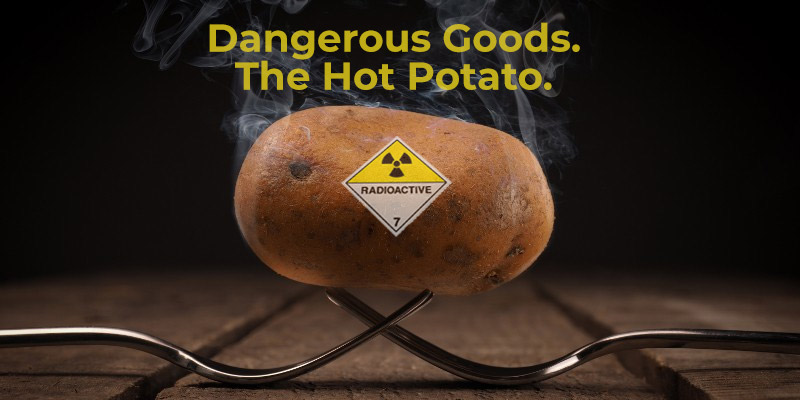
dangerous goods the hot potato of the freight industry. image potato steaming with radioactive label
The Essential Guide to Shipping Dangerous Goods
Shipping dangerous goods is no ordinary task, in fact, it’s the ‘hot potato’ of the freight industry. Many carriers will not touch it, because of the compliance and regulatory control placed around the shipment of Dangerous Goods. However, shipping Dangerous Goods is an everyday occurrence, so whether you’re running a business with limited knowledge, and you need to ship dangerous materials or products, then this guide may help.
We wrote this guide to help our customers, who use the One World Courier Freight Management Platform to send and receive shipments containing Dangerous Goods (DG’s). The contents of shipments could be Lithium Batteries contained in products, or battery accessories. Some DG’s are also what you’d not even consider to be on the list of substances which represent a danger when shipped.
Classifying Dangerous Goods
Dangerous goods, often referred to as hazardous materials, include substances that pose risks to health, safety, property, or the environment, either when stored or in transit. When dealing with Dangerous Goods and preparing them for transport, it pays to be aware of how they are classified, and which materials fall into each category. Dangerous Goods can be in the form of solids, liquids, or gases, and represent a real threat if not handled and transported correctly. The classification of these goods is based on their unique properties and potential risk.
For instance:
- Explosives: Materials that can cause a sudden release of pressure and gas when subjected to sudden shock.
- Gases: Compressed, liquefied, or dissolved under pressure, including propane and aerosols.
- Flammable Liquids: Liquids with a low flash point like gasoline or solvents.
- Corrosive Substances: Materials that can degrade or disintegrate other materials upon contact.
Dangerous Goods Transportation – Air Couriers
Transportation of Dangerous Goods, especially when considering the prospect of worldwide shipping by air, presents a substantial threat to life and property. Aircraft cargo holds, although contain all manner of safety devices to prevent fire, the threat of explosion is forever present when Dangerous Goods are on board. We’re all familiar with not packing any devices containing Lithium Ion or Lithium Metal batteries in our checked-in baggage. When shipping goods containing certain Dangerous Goods, most airlines will not ship, and sea freight is recommended.
Dangerous Goods Shipping – One World Courier International Air Courier Freight Partners
How to ship dangerous goods safely begins with choosing the most suitable carrier who has specific guidelines on carrying Dangerous Goods on international air routes, or domestic routes in Australia.
The transportation of Dangerous Goods and sending/receiving Dangerous Goods processes has been in-built into the One World Courier Freight Platform. Dangerous Goods Air Freight has become more common as the demand for devices containing lithium-based batteries gains popularity. Devices with batteries contained in the device, which are permanently soldered on to circuit boards, motherboards are more common than ever. These devices can be shipped by air, although there are protocols and regulations that must be followed – such as draining batteries to almost empty.
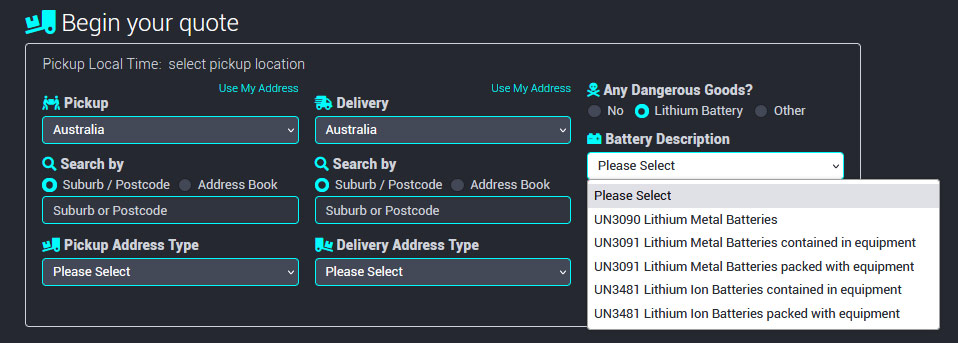
One World Courier dangerous goods freight management platform, selecting lithium batteries.
The above image shows the One World Courier freight booking platform which has been geared to book dangerous goods items. Our extensive freight partnership arrangements and agreements authorise us to book in dangerous goods with our carriers. Extensive development work has been carried out to adhere to strict dangerous goods shipping protocols. Our Freight Operations Teams and Customer Service and Support Teams engage with our carrier and courier partners to makes sure all shipments meet transport of dangerous goods carriage specifications.
Dangerous Goods Material Safety Data Sheet (MSDS)
The Material Safety Data Sheet – better known as MSDS, is a supporting document that contains detailed information on the contents of the shipment. Its purpose is to provide a technical breakdown of the components or substances contained in the shipment to prove that it does not fall under the Dangerous Goods (DG) category. See further down the page for our Dangerous Goods classification breakdown, where we classify the different types of Dangerous Goods, the materials and the impact of improper transportation.
The MSDS, or Material Safety Data Sheet, serves as a comprehensive guide for chemical safety. It informs users about the potential dangers of chemicals to ensure everyone’s safety. Not only does it offer guidelines for safely working with hazardous chemicals, but it also provides essential information for emergency situations, like spills or accidents.
- Documentation: The Dangerous Goods Material Safety Data Sheet declaration (MSDS) details the goods being shipped, its Dangerous Goods classification, and handling information.
- Packaging: The packaging for hazardous materials is crucial and varies based on the substance. Always ensure containers are robust, sealed, and labeled correctly with the correct label to identify the Class and appropriate contamination advice. It’s always recommended to use the original manufacturer’s packaging when possible.
- Labeling: Proper labeling provides handlers with immediate knowledge about the contents and associated risks. Labels should be clear, visible, and placed on a flat surface of the package.
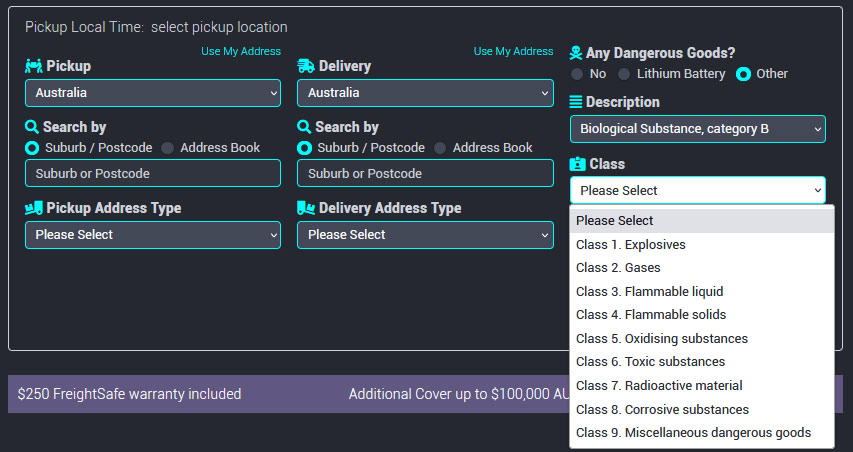
Selecting a Dangerous Goods Class in the One World Courier Freight Platform. In-built Dangerous Goods Classifications follow strict Australian DG guidelines.
9 classes of Dangerous Goods
There are 9 classes of dangerous goods outlined in the Australian Dangerous Goods Code. Dangerous goods are classed according to their physical and chemical properties — and the risks that they present.
A Simplified Guide to the 9 Classed of Dangerous Goods
1. Explosives (Class 1)
This covers materials that can explode unintentionally due to inappropriate handling or storage. Class 1 categorises them based on their specific explosive characteristics.
- 1.1: Can explode. Dynamite, TNT, and certain types of fireworks fall into this category. When these materials detonate, the explosion releases a lot of energy. It’s crucial to handle and transport these types of goods with the utmost caution due to their volatile nature.
- 1.2: Might shoot out fragments, but won’t explode entirely. Flares, some firework types, and ammunition without a projectile fall into this category. While the entire materials won’t explode, they can shoot out fragments or pieces when ignited. This can pose a threat to nearby objects being transported in the same space, and also inflict significant injury to people working nearby.
- 1.3: Can catch fire and might pop or throw out bits, but won’t fully explode. Certain fireworks and signal devices are typical examples, because when they are lit, they can produce flames and may sporadically send out small fragments or sparks. Their primary risk is fire rather than a complete explosion, which is a huge threat for road transportation where full loads are a mix of general goods and Dangerous Goods.
- 1.4: Minimal danger and mostly safe. This includes safety matches, some toy caps, and small ammunition. While they contain explosive materials, the quantity and nature are such that it doesn’t pose a significant hazard. The explosions or reactions they produce are minimal and controlled.
- 1.5: Won’t easily explode, but if they do, it could be catastrophic. Bulk commercial explosives used in mining, like ANFO (Ammonium Nitrate Fuel Oil), are examples. These types are designed and produced to be stable under most conditions. Their stability is their strength; however, if something goes wrong, the results can be catastrophic.
- 1.6: Safe articles that won’t have a massive explosion. Devices like certain types of detonators and igniters are in this category. They are designed to start reactions in other materials, and explosive devices, however, on their own, won’t produce a large-scale explosion. While they pose a minimal risk in isolation, in combination with other materials, they can be part of a larger explosive system.
2. Gases (Class 2)
Gases, due to their nature, can pose unique hazards when compared to solid or liquid substances. This is particularly true during transportation or storage, where containment and pressure become key factors. Class 2 is dedicated to these gases, categorizing them based on their specific risks.
Different types of gases with their respective dangers: These gases can vary in their potential harm based on their inherent properties, from being flammable to posing health hazards upon inhalation.
- 2.1: Can catch fire. Gases such as propane, hydrogen, and acetylene fall under the Class 2 category. These are flammable gases that can ignite easily when exposed to a spark, flame, or other ignition sources. These gases can lead to explosions or fires, therefore proper transport, storage and handling is essential. Barbecue grills, welding equipment, and certain types of vehicle fuel use gases in this category. Flammable gasses include propane, butane, and acetylene.
- 2.2: Safe gases that don’t burn or harm if inhaled. Examples of these gases include nitrogen, neon, and carbon dioxide. Often termed as inert or noble gases, they neither support combustion nor pose a direct health risk when inhaled in normal concentrations. These gases are commonly used in a range of applications, from food packaging to electronics manufacturing, due to their non-reactive nature. Balloons filled with helium, for example, utilize a gas that is safe to inhale and doesn’t support combustion. Special trucking and transportation companies handle these type of freight movements. They have specially designed trucks and cargo vessels to safely transport these goods. Safe gases include nitrogen, helium, and carbon dioxide. they don’t catch fire easily or pose direct health risks upon inhalation, they can still be dangerous. For instance, if they displace oxygen in a confined space, they can cause asphyxiation.
- 2.3: Harmful gases if inhaled. Chlorine, ammonia, and certain pesticides are examples of toxic gases. These gases need special handling precautions, not just because of their toxic nature, rather due to their potential environmental impacts. Chlorine, for instance, is used in water treatment and disinfection processes but can be lethal if leaked into the environment in large quantities. There are some carriers who will transport these goods, again, each carry special licenses and transportable containers to move the goods safely on public roads. Chlorine, ammonia, and hydrogen cyanide are a few examples.
3. Flammable Liquids (Class 3)
Flammable liquids are characterized by their ability to ignite easily and burn rapidly. These liquids have a low flash point, which means they can become ignitable at relatively low temperatures.
- Petrol: Commonly used as fuel for cars, trucks, and other vehicles, gasoline is highly flammable. Even its vapors can ignite, making it essential to handle gasoline with care, especially near open flames or sparks.
- Ethanol: Often found in alcoholic beverages, it’s also used in hand sanitizers, fuel, and as a solvent in labs. When used in high concentrations, such as in some industrial applications, its flammability becomes a significant concern.
- Acetone: Widely used as a solvent, especially in nail polish removers, acetone can easily catch fire. Its fumes are also flammable, which is why it’s recommended to use it in well-ventilated areas away from ignition sources.
- Methanol: Used as fuel, solvent, and antifreeze, methanol is not only flammable but also toxic when ingested.
- Turpentine: Commonly used as a solvent in paints, turpentine is derived from pine trees and is highly flammable.
4. Reactive Solids & Certain Conditions (Class 4)
Class 4 classifies substances that, while in solid form, can become hazardous under certain conditions. Some of the materials might burn or undergo hazardous reactions, while others might be prone to spontaneous ignition or produce flammable gases when exposed to water.
- 4.1: Solids that can burn or react when triggered.
These are materials that, while stable under regular conditions, can combust or react violently when subjected to physical shock, friction, or specific environmental conditions.- Metal powders, like magnesium or aluminium, can combust when exposed to a spark or high temperatures.
- Picric acid: Commonly used in laboratories, this chemical can become explosive if it crystallizes and is then subjected to shock or friction.
- Some pesticides and fertilizers: They can ignite or explode under specific conditions.
- 4.2: Substances that can self-ignite.
These substances don’t need an external ignition source. Given the right conditions (often related to temperature and air exposure), they can spontaneously catch fire.- Linseed oil-soaked rags: When piled together, they can generate heat and ignite spontaneously.
- Coal: Can self-heat and potentially ignite, especially when stored in large quantities.
- Some sulphide ores: Can heat up when exposed to air and catch fire.
- 4.3: If mixed with water, they release flammable gases.
Contact with water or humidity can lead to a chemical reaction with these substances, causing the release of flammable gases.- Sodium metal: Reacts vigorously with water, producing hydrogen gas, which can ignite or even explode.
- Calcium carbide: Produces acetylene, a flammable gas, when it comes into contact with water.
- Metal hydrides: Can release hydrogen gas upon contact with water.
5. Oxidizers & Special Chemicals (Class 5)
Class 5 consists of substances that either support combustion by yielding oxygen or are chemically unstable and can react in hazardous ways under certain conditions. While they might not necessarily burn themselves, they can greatly intensify the combustion of other materials.
- 5.1: Substances that help other materials burn.
These substances can release oxygen, making it easier for other materials to ignite and sustain combustion. They don’t always need an open flame to start a reaction; sometimes, mere contact with an incompatible material is enough.- Potassium nitrate: Used in fertilizers and as a food preservative, it can intensify the burning of combustible materials.
- Hydrogen peroxide (in high concentrations): While commonly known as a disinfectant in lower concentrations, in higher concentrations it can be a powerful oxidizing agent.
- Liquid oxygen: Used in rocket propulsion, it can make combustible materials burn violently.
- 5.2: Special chemicals that can react dangerously.
These are organic compounds that can be thermally unstable and may undergo explosive decomposition. Some might require controlled temperatures or be kept away from sources of ignition.- Benzoyl peroxide: Often used in acne treatments, in larger quantities and concentrations, it can be explosive.
- Tetrahydrofuran (THF): A common solvent in laboratories, it can form explosive peroxides over time, especially when exposed to air.
- Dicumyl peroxide: Used in the production of plastics and rubbers, it can be explosive when subjected to heat or shock.
6. Harmful & Disease-Causing Substances (Class 6)
Class 6 substances encompass those that are hazardous to human health, either due to their toxic nature or because they can cause disease. These substances require careful handling to ensure safety.
- 6.1: Harmful if contacted or consumed.
These are toxic substances that can cause harm if ingested, inhaled, or if they come in contact with skin. The harm they cause can range from mild irritations to severe health effects or even death, depending on the substance and the exposure level.- Cyanide: Highly toxic and can be deadly if ingested or inhaled. Used in mining to extract gold and silver from ores, in electroplating, and in certain chemical processes.
- Mercury: Toxic heavy metal that can harm the nervous system. Found in some thermometers, barometers, and batteries.
- Arsenic: Can be poisonous if consumed. Often used in wood preservatives, pesticides, and in some alloys.
- Certain pesticides: Can be toxic to humans and may cause harm if ingested, inhaled, or absorbed through the skin.
- 6.2: Can cause diseases.
These substances are infectious and can lead to diseases in humans or animals. They may contain pathogens like bacteria, viruses, or other microorganisms.- HIV: The virus responsible for AIDS. While primarily transmitted through body fluids, it can also be found in medical samples or research materials.
- Tuberculosis bacteria: Causes tuberculosis, a severe lung disease. Can be present in laboratory samples.
- Certain biohazardous wastes: Such as used syringes or tissues from infected patients.
- Viral cultures: Used in research labs, these can contain disease-causing viruses.
7. Radioactive Material (Class 7)
Class 7 encompasses substances that emit ionizing radiation. This radiation comes from unstable atoms, which can be naturally occurring or artificially created. While some applications of radioactive materials have revolutionized industries like medicine, energy, and research, it’s essential to handle and transport them safely because of the potential health hazards associated with radiation exposure.
Materials that emit radiation. These substances release energy in the form of particles or electromagnetic waves. Prolonged or high-level exposure can damage living tissues, leading to health issues, including an increased risk of cancer.
- Uranium: A naturally occurring element that’s used as fuel in nuclear power plants. In its refined form, it can be used to produce energy, but its radioactive properties also mean it’s a potential hazard.
- Radium: Once used in luminous paints, it’s now mostly obsolete because of its high radioactivity.
- Medical isotopes: These are used in various medical procedures, especially in diagnostic imaging. An example is Technetium-99m, which is widely used in medical imaging but decays quickly.
- Radioactive tracers: Used in industry and research to study the flow of materials and processes. These tracers are often short-lived, but while active, they emit radiation.
- Spent nuclear fuel: After being used in a reactor, nuclear fuel remains radioactive and needs to be handled with extreme care.
8. Corrosives (Class 8)
Class 8 substances are known for their aggressive nature towards other materials, especially in their ability to degrade metals and destroy living tissues on contact. These chemicals have a wide range of industrial applications, but their powerful reactive properties necessitate careful handling and storage.
Substances that can eat through or damage other materials.
These are materials that, when in contact, can cause irreversible damage to other materials, including metals and organic tissues. Their destructive nature is usually a result of a chemical reaction, such as acid reacting with metal or skin.
- Sulfuric acid: Used in battery production, metal processing, and chemical synthesis, it can cause severe burns on contact with skin and can corrode metals.
- Hydrochloric acid: Found in many industrial applications, including the production of chlorine and as a pH regulator in various processes.
- Lye (sodium hydroxide): A strong base used in soap making, drain cleaning, and various chemical processes. It’s caustic and can cause burns if it comes into contact with skin.
- Battery acid: Used in lead-acid batteries, it’s capable of corroding metals and causing burns.
- Ammonia: While commonly used as a household cleaner in diluted form, in concentrated levels, it can be corrosive to certain materials.
9. Miscellaneous Risks (Class 9)
Class 9 encompasses a diverse range of substances and articles that don’t quite fit into the other eight classes but still pose a potential hazard during transportation or storage. Their varied nature means that they require special consideration to ensure safety.
Various substances and articles with specific risks.
- Lithium batteries: Popular in many modern electronic devices, they can pose a fire risk if damaged or short-circuited.
- Asbestos: Once widely used for its heat-resistant properties, it’s now known to cause respiratory diseases and is considered hazardous.
- Environmentally hazardous substances: Chemicals that might not be immediately harmful to humans but can cause environmental damage if released.
- Dry ice (or solid carbon dioxide): Used for cooling, it sublimates (turns from a solid directly into a gas) and can increase pressure inside a container, potentially causing an explosion.
- Life-saving appliances: Such as life rafts that contain small gas cartridges for inflation.
Dangerous Goods Transportation – Our Air Freight Carriers
FedEx: Known globally for its extensive network, FedEx has clear guidelines for shipping dangerous goods.
Their Dangerous Goods Shipping Statement says: Dangerous goods are articles or substances which are capable of posing a hazard to health, safety, property or the environment. They need to be packed, marked, labelled and documented properly, handled carefully and shipped by personnel who have received dangerous goods training to ensure they arrive safely at their destination. FedEx have a requirement to email shipping quote requests for every Dangerous Goods shipment that are not batteries. In most circumstances, a response will be received within 48 hours
UPS: Dangerous Goods packages must be prepared in accordance with ADR regulations for ground shipments and IATA regulations for air shipments. Shippers must make certain a package is correctly marked, packaged, labeled and documented. Their guide highlights the specifics of packaging, labeling, and documentation required for hazardous materials.
DHL: DHL are one of the more proactive air courier partners, although their policy is to only ship batteries, no other Dangerous Goods.
Dangerous Goods Compliant Shipping Booking Processes
The One World Courier Freight Platform was built to help Australian businesses manage their freight and shipping operations, and to simplify the whole process. We listened to 1000’s of companies and built a platform that was easy to use, as well as caters for the complexities of freight and logistics services.
Our multi-carrier freight platform makes it easy to search for carriers, get instant freight quotes (including Dangerous Goods shipping quotes), from a wide range of carriers and courier services, both in Australia and around the world. We’ve layered our technology platform with the latest innovations to allow our customers to spend less time working out which service suits their needs. We achieved this by building complex algorithms which only show shipping options from our partners who have the capacity to pick up and deliver the goods. We don’t waste time on showing dozens of results which over complicate the process. Even when it comes to Dangerous Goods shipments, we made it super-easy to select and classify the goods to ship.
Dangerous Goods – A Step-By-Step Walk-Through
1. Choosing the type of Dangerous Goods. No dangerous goods, Lithium Battery or Other. In this example we selected ‘Lithium Battery’.

2. Choosing the type of Dangerous Goods. No dangerous goods, Lithium Battery or Other. In this example we selected ‘Lithium Battery’.

Lithium battery selection. Selecting the correct battery type classification using international standard UN number. Lithium Metal or Lithium Ion battery.
3. Selecting the ‘Packing Group’ for Lithium Battery shipping.
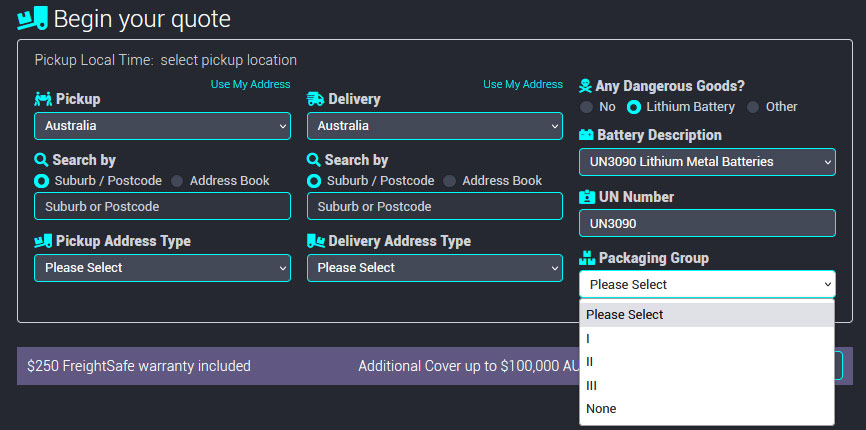
Selecting a packing group quantity type.
4. Dangerous Goods booking process. Selecting the ‘other’ option.Biological Substance, Category B, Dry Ice, Genetically Modified Organisms, Limited Quantities.
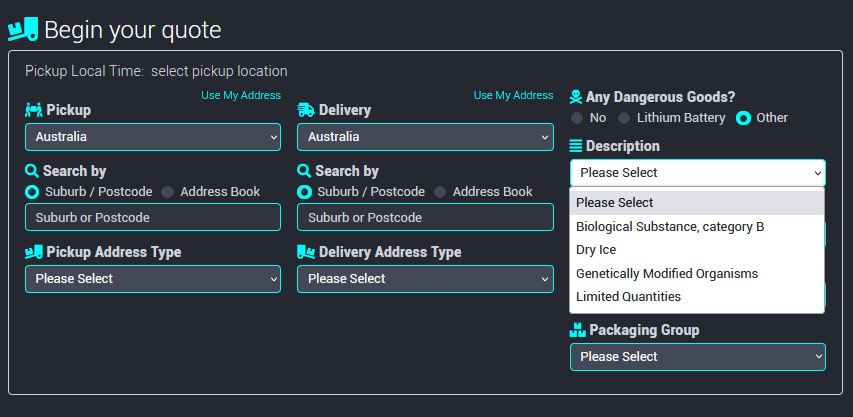
Selecting ‘other’ type of dangerous goods. Selecting the appropriate type of ‘other’ Dangerous Goods. This is where DG classification types are mapped to the booking process.
5. Selecting the ‘other’ option, using Biological Substances, Category B as the selected Dangerous Goods classification. Here we can see the DG Classifications as outlined above.

Classifying dangerous goods using Biological Substances as the drop down. Showing the full dangerous goods classification types.
6. Finalising the ‘Other’ category of Dangerous Goods in the freight portal. Easily see the full details in our platform, then add a UN number to classify the type of goods.
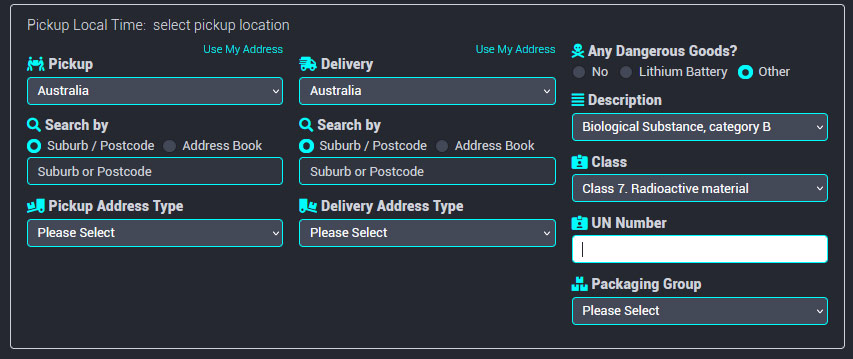
Adding a UN number to a Dangerous Goods shipment booked through One World Courier Freight Portal. Essential details are critical when shipping Dangerous Goods. These details form part of the MSDS.
Dangerous Goods Classification – Quick Reference
- Class 1: Explosives (e.g. fireworks or flares)
- Class 2: Flammable gas, non-flammable gas/non-toxic gas, toxic gas (e.g. aerosols or camping gas)
- Class 3: Flammable liquids (e.g. paints and solvents)
- Class 4: Flammable solids,Substances liable to spontaneous combustion,Substances which, in contact with water, emit flammable gas (e.g. matches, calcium carbide, phosperous)
- Class 5: Oxidizers (e.g. fibreglass repair kits, fertilizer etc)
- Class 6: Toxic substances (e.g. pesticides)
- Class 7: Radioactive material (e.g. smoke detectors)
- Class 8: Corrosives (drain cleaners or bleaches)
- Class 9: Miscellaneous dangerous goods substances and articles (e.g. magnets, lithium batteries, air bags and dry ice)
One World Courier is a provider of a FREE to use freight platform, allowing customers to compare, book, pay for and manage shipping operations with ease.
Read our other Dangerous Goods article here and our Dangerous Goods brochure PDF.

